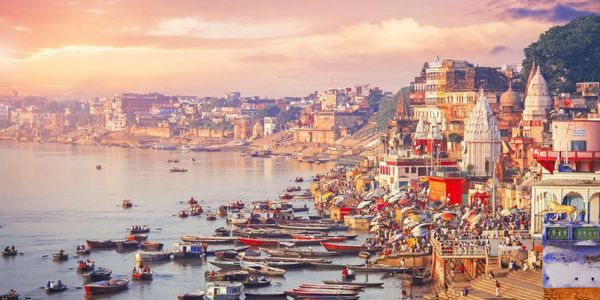How to Plan a Varanasi City Tour: A Complete and Unique Guide
 Rawat Sikhar
24 Jan, 2025
13 mins read
153
Rawat Sikhar
24 Jan, 2025
13 mins read
153

Varanasi is a city that challenges your sense of time and invites you to step into a world where history, spirituality, and culture blend into an intoxicating mix. Known as Kashi or Banaras, Varanasi stands as one of the world’s oldest continuously inhabited cities and is regarded as the spiritual heart of India. The city beckons not only pilgrims but also travelers with a thirst for authenticity, culture, and unparalleled experiences. Planning a visit to Varanasi requires more than just logistics; it involves understanding the city’s rhythm, respecting its rituals, and immersing yourself in its atmosphere.
If you’re planning a trip to Varanasi, this guide will help you navigate the city’s historical streets, sacred ghats, famous temples, and mystical riverbanks. Whether it’s your first time visiting or you're looking for something deeper, here’s a unique and comprehensive approach to planning your Varanasi city tour.
Step 1: Best Time to Visit Varanasi – When to Experience Its Magic
Understanding the seasonal dynamics of Varanasi is essential in order to plan an enjoyable trip. The city’s cultural and spiritual allure remains consistent throughout the year, but the weather and festive periods can significantly alter your experience.
- Winter (October to March): The best time to visit Varanasi is during the winter months, when the air is cool and crisp. With temperatures ranging from 10°C to 20°C (50°F to 68°F), this is the ideal season to explore the ghats and temples, enjoy a boat ride at dawn, and participate in outdoor rituals. The atmosphere around this time is peaceful, and the city is buzzing with pilgrims coming to seek spiritual solace. Festivals like Diwali (October-November) and Makar Sankranti (January) lend an even more captivating energy to the city.
- Summer (April to June): Summer in Varanasi can be intense, with temperatures often reaching over 40°C (104°F). While this heat may be uncomfortable for outdoor activities, the cooler mornings and evenings offer some respite. If you don’t mind the heat and prefer fewer crowds, summer can still be a good time to visit. The benefit here is the opportunity to experience the city in its quieter moments, without the rush of tourists.
- Monsoon (July to September): The monsoon season brings lush greenery to the city, but it also brings heavy rainfall. The ghats can sometimes get flooded, and streets may become slippery. If you choose to visit during this time, be prepared for humidity and occasional interruptions due to rain. However, monsoon also offers a serene, almost spiritual atmosphere as the rain clouds drift over the Ganges.
- Festivals: Varanasi is a city of festivals, each one intensifying the vibrancy of the place. Major festivals such as Holi (March), Diwali (October-November), and the Kumbh Mela (which takes place once every 12 years) are celebrated in a grand and fervent manner. These festivals often attract larger crowds, but they also offer a unique opportunity to witness cultural events at their peak.
Step 2: Arriving in Varanasi – Transport Tips and Recommendations
Varanasi is well connected to other cities in India by air, rail, and road. The journey to this sacred city can be an adventure in itself, and each mode of transport offers its own experience.
- By Air: Varanasi’s Lal Bahadur Shastri International Airport (VNS) is the city’s main gateway, offering domestic flights from cities like Delhi, Mumbai, Kolkata, and Lucknow. If you’re traveling internationally, you’ll likely fly into Delhi or Mumbai first and then connect to Varanasi. The airport is around 25 kilometers (15.5 miles) from the city center, and taxis are available for easy access.
- By Train: Varanasi Junction (also called Varanasi Cantt) is one of India’s busiest and most prominent railway stations. It connects well with major cities like Delhi, Kolkata, and Mumbai. Trains to and from Varanasi can be a convenient, scenic, and affordable option, with sleeper classes and more comfortable air-conditioned coaches.
- By Road: The city is easily accessible by road from nearby cities like Lucknow (320 km), Allahabad (120 km), and Patna (250 km). Bus services, as well as taxis and private cars, are available. The roads in and around Varanasi can sometimes be crowded, so make sure you plan extra time for travel.
Step 3: Accommodation Choices – Where to Stay in Varanasi
Your choice of accommodation will significantly impact your experience of Varanasi, and the options vary depending on the ambiance and location you desire.
- Staying Near the Ghats: For a truly immersive experience, staying near the ghats offers a front-row seat to Varanasi’s spiritual life. Hotels and guesthouses around Dashashwamedh Ghat or Assi Ghat provide easy access to the river, temples, and the sacred rituals of the city. While this area can be lively and chaotic, it also places you right in the heart of Varanasi’s cultural and spiritual activity. Some accommodations even offer beautiful river-view rooms for watching the morning and evening rituals.
- In the City Center: If you prefer a quieter, more comfortable stay with modern amenities, the city center offers hotels with easy access to markets and attractions. Staying in areas like Lanka, Godowlia, or near BHU (Banaras Hindu University) offers a blend of convenience and local flavor.
- Luxury Options: For those seeking a more luxurious experience, properties like the Taj Nadesar Palace and Radisson Hotel Varanasi provide comfort and elegance with modern amenities. These hotels offer a serene atmosphere and superior service, which can be a great way to relax after a long day of exploring.
- Budget-Friendly Stays: Varanasi has numerous budget accommodations ranging from hostels to guesthouses. Many of these are basic but clean, offering a homey atmosphere that suits those traveling on a tight budget.
Step 4: Designing Your Itinerary – A Spiritual and Cultural Journey
Varanasi is a city of discovery, where every corner holds a new experience. To get the most out of your visit, here’s a three-day itinerary designed to offer both iconic highlights and intimate encounters with the soul of the city.
Day 1: Embrace the Spirit of the Ganges
- Morning:
- Start your day early with a boat ride along the Ganges, as the sun rises over the sacred river. The early morning light, the chanting of mantras, and the peaceful rituals happening along the ghats make it a spiritually moving experience. Begin your boat ride at Assi Ghat or Dashashwamedh Ghat and experience the spiritual pulse of the city.
- Mid-Morning:
- Visit the Kashi Vishwanath Temple, one of the most famous Hindu temples, dedicated to Lord Shiva. Expect crowds, but the energy is palpable. Afterward, stroll through the narrow alleys to catch a glimpse of local life.
- Afternoon:
- Walk down the ghats to visit Manikarnika Ghat, where Hindu cremations take place. The site is integral to the life-and-death cycle of Varanasi, where the river becomes a link to the divine. It’s a powerful and profound experience.
- Evening:
- Attend the mesmerizing Ganga Aarti at Dashashwamedh Ghat, a daily ritual that is both visually and spiritually captivating. Watch as priests offer prayers and fire to the river, accompanied by music and chanting, creating a hypnotic atmosphere.
Day 2: Temples, Culture, and Hidden Gems
- Morning:
- Begin your day with a visit to the Sankat Mochan Hanuman Temple, less crowded but equally important to the locals. Its peaceful surroundings make it a great place to reflect.
- Explore the stunning Banaras Hindu University (BHU) campus and visit the Vishwanath Temple within the campus.
- Afternoon:
- Head to Ramnagar Fort across the river. The fort provides a glimpse of the royal family’s lifestyle and houses an interesting museum showcasing artifacts, royal dresses, and vintage cars.
- Evening:
- Experience the charm of Kedar Ghat or Raja Ghat, two lesser-known ghats where you can find tranquility away from the crowds.
Day 3: Exploring Sarnath and the Mystique of Varanasi
- Morning:
- Take a short trip to Sarnath, the place where Buddha gave his first sermon after enlightenment. Visit the Dhamek Stupa and the archaeological site to learn about the city’s Buddhist heritage.
- Afternoon:
- Discover the vibrant local markets of Varanasi, particularly the ones near Kashi Vishwanath Temple. Whether you’re looking for handwoven silk scarves, brass statues, or traditional jewelry, Varanasi’s markets are filled with treasures.
- Evening:
- Finish your trip with a peaceful evening walk along the Assi Ghat and soak in the atmosphere one last time. The setting sun and the lights of the temples create a magical ambiance.
Step 5: Etiquette and Practical Travel Tips
- Respect Local Customs: Varanasi is a deeply spiritual place, and it's important to approach it with respect. Dress modestly, especially when visiting temples or attending religious ceremonies.
- Stay Hydrated: The heat can be intense, especially during summer. Carry a water bottle, and always wear a hat or carry an umbrella to shield yourself from the sun.
- Be Cautious at the Ghats: While the ghats are beautiful, they can be crowded and sometimes chaotic. Be cautious of your belongings and avoid engaging with aggressive vendors.
- Photography Etiquette: Always ask for permission before taking photos, especially during religious ceremonies. Some temples and ghats have restrictions on photography.
Conclusion
A journey through Varanasi is unlike any other. The city’s spirituality, rich culture, and deep-rooted history create an atmosphere that is both captivating and humbling. By planning your visit with mindfulness and respect, you’ll gain a deeper understanding of not only the city but also of life itself. Varanasi invites you to explore its many layers—whether through a boat ride on the Ganges, attending the sacred rituals, or wandering through its ancient temples and vibrant markets. Every moment spent in Varanasi has the potential to transform you.
Written By:
Rawat Sikhar



Hotels at your convenience
Now choose your stay according to your preference. From finding a place for your dream destination or a mere weekend getaway to business accommodations or brief stay, we have got you covered. Explore hotels as per your mood.





